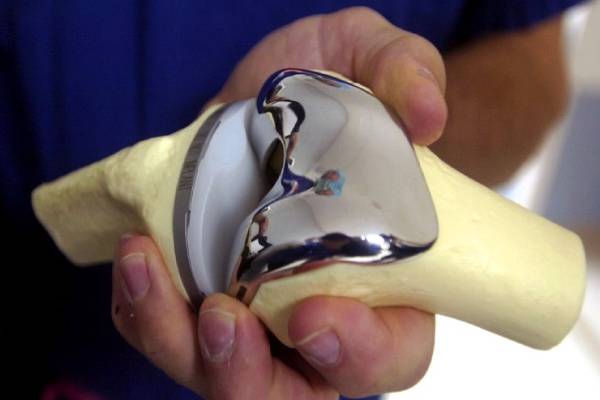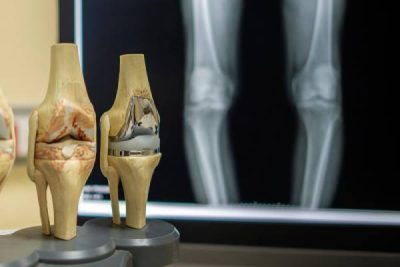ترجمه نوشته:

Complete knee replacement package in Iran (Shiraz)
Knee replacement surgery is one of the most advanced treatments for patients who suffer from pain and limited mobility due to severe arthritis, joint injuries, or chronic knee problems. The surgery is performed to reduce pain, improve mobility, and restore the patient’s quality of life. Iran, especially the city of Shiraz, has become a popular destination for complex treatments such as knee replacement due to its expert doctors, use of the latest surgical techniques, and affordable costs.
Steps of knee replacement surgery
Initial consultation and detailed evaluation: After contacting the doctor, the patient undergoes an initial examination. The doctor uses imaging such as X-rays and MRI to examine the condition of the knee joint and determine whether joint replacement surgery is appropriate. These evaluations help the doctor choose the optimal treatment method.
Preparation for surgery: Before surgery, the patient’s general health should be evaluated. Blood tests, heart and lung tests, and an assessment of the patient’s mental status are performed to ensure the patient’s ability to tolerate surgery.
Performing the surgery: Knee replacement surgery is usually performed under general or local anesthesia. The doctor makes an incision in the knee area, removes the damaged joint, and replaces it with an artificial joint. These artificial joints are usually made of high-quality metal and plastic that are designed to last a long time.
Recovery and Physical Therapy: After surgery, the patient will need to be hospitalized. During this time, physical therapy will begin to gradually restore mobility and flexibility of the knee. The patient may need the assistance of a walker or crutches for the first few weeks.
Types of knee replacement surgery methods
Traditional surgery: In this method, the doctor makes a large incision in the knee area and replaces the damaged joint. This method is suitable for patients who have suffered more severe injuries and need more comprehensive treatment.
Minimally invasive (mini-invasive): In this method, the surgeon uses smaller incisions and advanced techniques to reduce pain and speed up recovery time. This method is suitable for patients with early-stage knee problems.
Robotic technique: In advanced surgeries, robotic technology is used to provide greater precision in joint placement. This technique reduces human error and improves surgical outcomes.
Anesthesia and pain control
Knee replacement surgery is usually performed under general or local anesthesia. The type of anesthesia depends on the patient’s physical condition and preference. After surgery, advanced pain management, such as analgesics and nerve blocks, is used to control pain so that the patient can recover more easily.
Advantages and disadvantages of knee replacement surgery
Advantages:
Significant pain reduction: After surgery, many patients report significantly reduced joint pain and improved mobility.
Return to daily activities: Successful surgery can help the patient return to daily activities and light exercise.
Increased quality of life: Patients who suffered from chronic pain are usually able to perform simpler tasks after surgery, such as walking, climbing stairs, and exercising.
Disadvantages:
Long recovery period: Recovery from knee replacement surgery may take 4-6 weeks.
Risk of surgical complications: As with any surgery, there are risks such as infection, bleeding, or damage to nerves and blood vessels, although these are rare.
Doctors' expertise and experience in Iran
Iranian doctors have extensive experience in orthopedic surgery, especially knee replacement. Many of these doctors have completed their education at prestigious international universities and over the years have been able to increase the success rate of this type of surgery by using modern surgical techniques.
Why is knee replacement affordable in Iran?
One of the reasons for the popularity of medical surgeries in Iran is the lower costs compared to Western countries. The costs of surgery, hospitalization, medications, and physiotherapy in Iran are much lower than in developed countries, while the quality of medical services and hospital standards are at a high level.
Arvan Health Group Services in Shiraz
Arvan Health Tourism Group in Shiraz provides comprehensive and special welfare services for international patients. These services include:
Accommodation in five-star hotels with special amenities.
Translation and guidance: Professional translators in various languages for patient convenience.
Transportation: Private transportation service from the airport to accommodation and hospital.
Tourist tours: Visiting historical and cultural attractions of Shiraz such as Persepolis, Hafeziyeh, and Eram Garden.
Memorable memories from a trip to Shiraz
Shiraz, with its historical attractions such as the tombs of Hafez, Saadi, and Persepolis, provides an excellent opportunity for rest and sightseeing after surgery. In addition to treatment, this trip will be a memorable cultural and spiritual experience for patients and their companions.
General information
About knee replacement surgery
Anesthesia:
General
Recovery period:
Seven to ten days
Duration of surgery:
Two and a half hours
Duration of hospitalization:
Two to three days
Return to normal life:
Four to six weeks
Cost:
-
Arvan treatment packages
Click to check Arvan packages

To book an appointment and receive a free consultation, contact us now.
Frequently asked questions about knee replacement surgery

Surgery is recommended for people who are experiencing pain and disability, but most patients between the ages of 50 and 80 undergo knee replacement surgery.
The most common cause of pain after knee replacement is implant loosening, which can occur several years after the joint replacement. However, this is a rare cause of persistent pain.
When sleeping, you should elevate your legs with the help of several pillows, but be careful not to place the pillows behind your knees.
About 85 to 90 percent of knee replacement surgeries are successful for 10 to 15 years, depending on the patient's level of activity.
After surgery, you will use a walker for 3 weeks to help you walk, and then you will use crutches. After 4 to 8 weeks, you will be able to walk without crutches. But you will need to do physical rehabilitation for several months.
As knee surgery becomes more advanced, you may be put under general anesthesia to put you in a deep sleep, or your doctor may want to numb you with a spinal or epidural while keeping you awake. However, most people experience general anesthesia.
It may take three months to a year for the pain and swelling at the surgical site to go away, while normal activities can be resumed after three to six weeks. Therefore, it is best not to walk until the swelling and pain have subsided..
Articles related to knee replacement
✅ Complete travel guide to Qalat Village, Shiraz | A mountain tourism gem with a waterfall, church, and eco-lodge
-
Posted by
arwan.ad
- 0 comments
“Journey to the heart of Azeri culture; treatment, relaxation, and a unique experience with Arvan Health Tourism Group”
-
Posted by
arwan.ad
- 0 comments
Advantages and disadvantages of tummy tuck😱
-
Posted by
arwan.ad
- 0 comments





